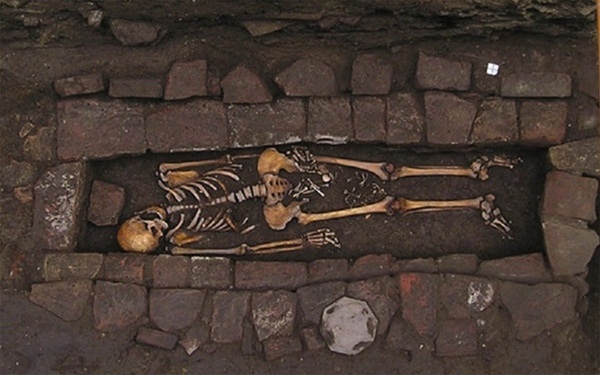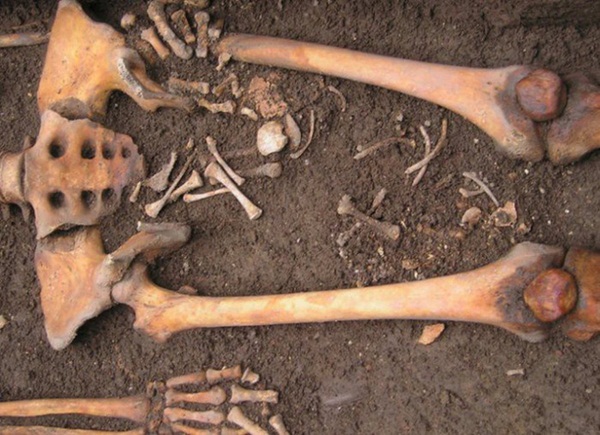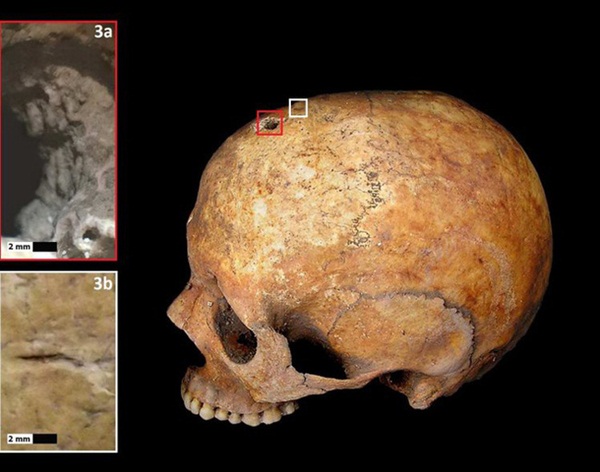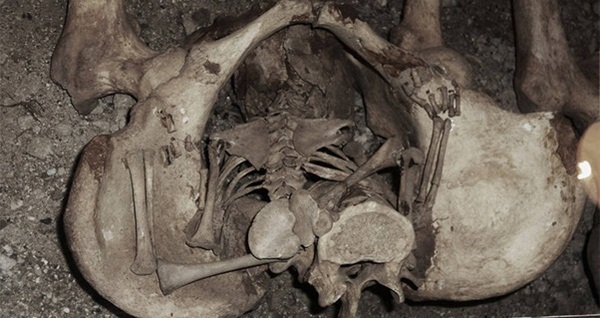Between the two femurs of the skeleton, small bone fragments were discovered, which were determined to be the skeleton of her unborn child.
In 2010, during an excavation in the town of Imola, near the city of Bologna, northern Italy, archaeologists discovered something extremely strange. The 1,300-year-old remains of a woman approximately 25-35 years old, had a hole at the top of the skull.
It is worth noting that in between the two femurs of the remains, small bone fragments were discovered that were identified as the skeleton of her unborn child.
 A 1,300-year-old skeleton was found with strange characteristics.
A 1,300-year-old skeleton was found with strange characteristics.
Writing in the study with a photo taken at the time of excavating the tomb, scientists noted that the fetal skeleton was in a very unusual position. The baby’s head and torso are located between the mother’s thigh bones, while the leg bones remain in the pelvic cavity.
After a period of research, scientists determined that the woman died while pregnant . She gave birth after she died and was buried, also known as the “coffin birth” phenomenon (birth in a coffin or extrusion after death).
 Archaeologists from the University of Ferrara and the University of Bologna tried to uncover the mystery of the death of mother and child in a new study published in the May 2018 issue of World Neurosurgery. Accordingly, researchers believe that these two particular remains may be a medieval example of a primitive brain surgery method called trepanation. The surgical process involves drilling or punching a small hole in the patient’s skull to relieve pressure to help treat a variety of diseases. But in this case, the surgery failed.
Archaeologists from the University of Ferrara and the University of Bologna tried to uncover the mystery of the death of mother and child in a new study published in the May 2018 issue of World Neurosurgery. Accordingly, researchers believe that these two particular remains may be a medieval example of a primitive brain surgery method called trepanation. The surgical process involves drilling or punching a small hole in the patient’s skull to relieve pressure to help treat a variety of diseases. But in this case, the surgery failed.
 Holes in the skull and small grooves.
Holes in the skull and small grooves.
“We hypothesized that the pregnant woman had pre-eclampsia and was treated with forehead bone drilling to reduce intracranial pressure. However, it seems that this method was ineffective so the pregnant woman did not survive and death with the fetus in the womb”.
Why is there a phenomenon of giving birth in a coffin?All we know after people die is the process of decomposing tissues and cells in the body. This is the key to the answer to this mysterious phenomenon. As decomposition proceeds, the rapid increase in the number of anerobic bacteria causes the amount of oxygen to decrease and leads to the accumulation of gases such as carbon dioxide and methane.
These gases not only make the body swell, but they also play a similar role to the factors that lead to prenatal contractions in a woman’s body during normal childbirth. When the volume of gases increases, it will impact, or more precisely, create pressure to push the fetus out of the mother’s body. So this rather strange phenomenon called coffin birth occurs during the decomposition of the human body.
 Although not witnessed firsthand, scientists speculate that when a pregnant woman’s body decomposes, it creates gas that accumulates inside the abdominal cavity. It is this amount of gas that creates pressure to push the fetus out.
Although not witnessed firsthand, scientists speculate that when a pregnant woman’s body decomposes, it creates gas that accumulates inside the abdominal cavity. It is this amount of gas that creates pressure to push the fetus out.
But the child’s exit path remains a question. Normally, a mother will deliver her baby through the vaginal canal. “But the cervix cannot dilate when the corpse has hardened,” said Jen Gunter, a gynecologist. “I suspect what actually happened was that the pressure from the accumulated gas pushed the fetus through a rupture in the uterus into the vagina, because the vagina is much thinner than the cervix.”
Regardless of how things happened, the child was definitely dead before it was born in the coffin.
In 1551, a Spanish woman was tortured and hung on the gallows, but 4 hours after her death, two babies were seen falling out of the mother’s womb in a state of respiratory arrest and still alive. dangling from the hanger. This is considered the first case of giving birth after death discovered and recorded in history.
 Illustration.
Illustration.
In 2005, in Hamburg (Germany), the body of a woman who died of a heroin overdose was discovered, her body was in the process of decomposition. After an autopsy, rescue workers discovered the baby’s head and shoulders had protruded from the woman’s vagina.
In 2008, in Panama, people discovered the decomposing corpse of a woman, and then they also found a decomposing fetus in her underwear.
In 2013, an Eritrean woman was on her way to Italy when the boat carrying her and others capsized. After finding the corpse, divers found a dead fetus in her pants.





